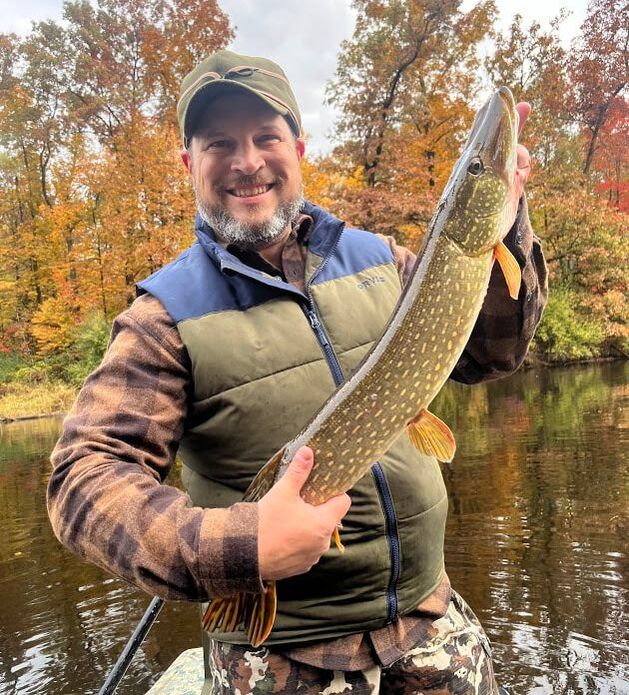|
Originally published in the February 2022 issue of Woods-n-Water News
By Drew YoungeDyke With a snowstorm in the forecast on a cold winter day, it’s natural to think about the opposite: a bright sunny day in June, green leaves reflected on the water, and stripping a popper next to a submerged log. Pop, pop, whoosh! A largemouth smashes the surface and tugs the fly deep into the cabbage, each twist sending vibrations down the tight 8-wt line as it tries to shake it off. The fight makes you think it’s a fish worthy of sparkle-boat plastered with sponsor logos as you kick or paddle your float tube, canoe or kayak over to it and net the bass, cabbage and all. Even a small bass leaves you smiling as you take a quick picture and release it. This scene is what bass fishing is to me, and it’s the experience that I’m tying flies for this winter while restocking my bass box. As voracious eaters, there are numerous effective patterns for largemouth and smallmouth bass, but this winter I’m focusing on the simplest patterns using the least materials, especially a variety of poppers and Clouser minnows, which are simple to tie and that I’ve had the most success with on bass. Before I started tying my own flies, I had the most success with the appropriately-named Orvis Bass Popper. Years before I started tying, I had bought a package of Zudbubbler popper bodies with the intention of learning to tie that I found in my old tackle bag, so I started tying poppers with those. While my skills were still developing, the flies floated well and popped hard and despite the sloppiness of my early ties, actually caught a few fish! One tied with yellow/black grizzly hackles I dubbed the “Killa Bee” in honor of the Wu-Tang Clan, and it even caught a few before I lost it. This winter I may buy some additional foam popper bodies but, to start, I’m going old-school by using actual wine bottle corks to make my poppers. The recipe is simple. Use a medium size streamer hooks up to size 1/0 – or even worm hooks with the barb pinched down. I wrap thread along the shank of the hook to provide a base to glue to for the cork body, which I cut into shapes with an open face, sloping back, and a range of widths with a flat bottom. I tie on a tail of either marabou, bucktail, or zonker strip at the beginning of the bend of the hook, followed by a collar of bucktail or hackle. I take one length of round rubber or sili-leg material, fold itin half, and tie it around the shank at its midpoint, leaving enough room in front of it for the popper body. Snip the resulting loop in the rubber legs to leave two legs extending down from each side. Next, cut a slit on the bottom of the cork body for the hook to slide into, extending about a third into the body. Next, apply superglue to the slot and fit it over the hook – ensuring the eye isn’t covered – and let it dry. The popper body can be left alone or finished with more detail by using a sharpie to draw eyes, spots and/or stripes, or by gluing on stick-on eyes. I’ve finished a few using Loon UV Hard finish in both clear and black, brushing a coating over the cork popper. Experiment with different colors; I’m focusing on olive, chartreuse, yellow, natural, white, and black this winter. The point of the popper is to provide a lot of topwater action, angering the bass into striking from its cover, with explosive topwater takes. It’s as fun as fly-fishing gets, in my opinion. If it floats, pops with each little strip, and you’re stripping it over cover in almost any small inland warmwater lake in Michigan, then each pop holds the anticipation of a strike. I usually fish these on an 8-wt floating line, or even my 9-wt floating line for bigger poppers to ensure a smooth turnover. While it’s not a stealth game with poppers, I still want to deliver the fly accurately to the spot I want without spooking the bass that may be in cover underneath. I want it take on the strip-pop, but be ready for a strike as soon as it lands on the water- I’ve had plenty of those, too. As the summer gets warmer and bass move to deeper cover, I switch to Clouser Minnows. This wispy little bucktail fly was developed for saltwater by the legendary Bob Clouser but has proven effective for multiple freshwater species including bass and northern pike. I’ve caught some nice crappies with Clouser minnows, too. And like all the flies I’m tying this winter, it is simple to tie and made with relatively few materials: a hook, thread, bucktail, nontoxic dumbbell eyes, and flash. These are usually tied two-tone with the darker color on top; chartreuse/white, olive/white, and red/white for pike are usually what I tie. I fish these with a floating 8-wt, a sink-tip, or a full sinking line depending on how deep I want to get. Again, use medium size streamer hooks up to size 1/0 or 2/0. It’s important to remember that the Clouser will ride hook-up, so if you do not have a rotating vice, you’ll be tying it upside down, so to speak. Wrap the thread from the hook eye to about halfway between the hook eye and the point of the hook. This is where the dumbbell eyes will be tied in. For tying in dumbbell eyes, I recommend watching a few YouTube tutorials to see some different options for holding them secure. With the hook down, tie in the dumbbell eyes on top of the hook shank. I always use nontoxic, nonlead dumbbell eyes because should you lose the fly or a fish breaks it off, nontoxic eyes will not poison eagles or loons as lead will. I use a combination of diagonal cross wraps, wraps in front of and behind the eyes, and wraps under the eyes, above the hook shank, to tighten them. End the wrap in front of the hook eye and make sure they’re level. At this point I add a drop of UV clear, head cement, superglue under the hook shank for extra security. Select a pencil-width of bucktail from the middle of the bucktail, Remove the short hairs and tie it in at a 45-degree angle in front of the dumbbell eyes, tying down with wraps up to the hook eye and back. Loop the thread under the dumbbell eyes and tie the bucktail down behind the eyes with a couple tight wraps, then a few open spiral wraps down the hook shank and back up to the eye of the hook. Next, tie in a couple strands of flash, folded in half around the tying thread, the length of the bucktail, along the belly of the fly. Finally, add a similar or slightly larger clump of the darker bucktail and tie it in under the fly in front of the dumbbell eyes, and whip finish. I’ll add UV clear fly finish or head cement to the head of the fly, as well. When riding hook up, the darker color should be on top, imitating a minnow. Cork bass poppers and Clouser minnows are two of the simplest patterns to tie to catch bass on the fly. If you’re a beginner fly-tyer, these are great ones to learn on to develop confidence and catch fish. Woolly buggers can also be effective. Watch YouTube videos to see how the flies are tied, as well as books like The Orvis Fly-Tying Guide by Tom Rosenbauer. Alvin DeDeaux also has a great YouTube series on “guide flies” that he ties for Guadalupe Bass in Texas using very simple materials. If you’re a more advanced fly tyer, I’d recommend checking out the Schultz Outfitters YouTube page for tying some of their patterns, Mad River Outfitters out of Ohio, or Blane Chocklett’s Game Changer. Next month, I’ll describe some simple northern pike flies to tie for voracious warmwater action. |
AUTHOR
Drew YoungeDyke is an award-winning freelance outdoor writer and a Director of Conservation Partnerships for the National Wildlife Federation, a board member of the Outdoor Writers Association of America, and a member of the Association of Great Lakes Outdoor Writers and the Michigan Outdoor Writers Association.
All posts at Michigan Outside are independent and do not necessarily reflect the views of NWF, Surfrider, OWAA, AGLOW, MOWA, the or any other entity. ARCHIVES
June 2022
SUBJECTS
All
|


 RSS Feed
RSS Feed